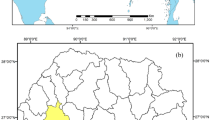Abstract
In western China seismic wave fields are very complicated and have low signal to noise ratio. In this paper, we focus on complex wave field research by forward modeling and indicate that density should not be ignored in wave field simulation if the subsurface physical properties are quite different. We use the acoustic wave equation with density in the staggered finite-difference method to simulate the wave fields. For this purpose a complicated geologic structural model with rugged surfaces, near-surface low-velocity layers, and high-velocity outcropping layers was designed. Based on the instantaneous wave field distribution, we analyzed the mechanism forming complex wave fields. The influence of low velocity layers on the wave field is very strong. A strong waveguide occurs between the top and base of a low velocity layer, producing multiples which penetrate into the earth and form strong complex wave fields in addition to reflections from subsurface interfaces. For verifying the correctness of the simulated wave fields, prestack depth migration was performed using different algorithms from the forward modeling. The structure revealed by the stacked migration profile is same as the known structure.
Similar content being viewed by others
References
Baysal, E., and Kosloff, D. D., 1984, A two-way nonreflecting wave equation: Geophysics, 49(2), 132–141.
Berenger, J. P., 1994, A perfectly matched layer for the absorption of electromagnetic waves: J. Comput. Phys., 114, 185–200.
Chang, W. F., and McMechan, G. A., 1986, Reverse-time migration of offset vertical seismic profiling data using the excitation-time imaging condition: Geophysics, 51(1), 67–84.
Chen, X. H., and Mou, Y. G., 1996, Two dimensional nonlinear wave equation inversion of seismic data: Chinese J. Geophys. (in Chinese), 39(3), 401–408.
Cheng, B. J., Li, X. F., and Long, G. H., 2008, Seismic waves modeling by convolutional Forsythe polynomial differentiator method: Chinese J. Geophys. (in Chinese), 51(2), 531–537.
Clayton, R., and Engquist, B., 1977, Absorbing boundary conditions for acoustic and elastic wave equations: Bull. Seis. Soc. Am., 67(6), 1529–540.
Collino, F., and Tsogka, C., 2001, Application of the perfectly matched absorbing layer model to the linear elastodynamic problem in anisotropic heterogeneous media: Geophysics, 66(1), 294–307.
Fu, C. M., Di, Q. Y., and Wang, M. Y., 2009, 3D numeric simulation of marine controlled source electromagnetics (MCSEM): Oil Geophysical Prospecting, 44(3), 358–363.
Fu, H. S., and Han, B. A., 2005, Regularization homotopy method for the inverse problem of 2-D wave equation and well log constraint inversion: Chinese J. Geophys. (in Chinese), 48(6), 1441–1448.
Higdon, R. L., 1991, Absorbing boundary conditions for elastic waves: Geophysics, 56(2), 231–241.
Hong, T. K., and Kennett, B. L. N., 2004, Scattering of elastic waves in media with a random distribution of fluid-filled cavities: Theory and numerical modeling: Geophys. J. Int., 159, 961–977.
Kosloff, R., and Kosloff, D., 1986, Absorbing boundaries for wave propagation problems: J. Comput. Phys., 63, 363–376.
Liao, Z. P., Wong, H. L., Yang, B. P., and Yuan, Y. F., 1984, A transmitting boundary for transient wave analyses: Scientia Sinica, Series A, 27(10), 1063–1076.
Mu, Y. G., and Pei, Z. L., 2005, Seismic numerical modeling for 3-D complex media: China Petroleum Industry Press.
Muijs, R., Robertsson, J. O. A., and Holliger, K., 2007, Prestack depth migration of primary and surface-related multiple reflections: Part I-imaging: Geophysics, 72(2), S59–S69.
Qiu, D. L., Zhou, H., Takenaka, T., and Tanaka, T., 2006, Source group method to speed up the reconstruction of objects from radar data by using the FBTS method: Microwave and Optical Technology Letters, 48(1), 67–71.
Reynolds, A. C., 1978, Boundary conditions for the numerical solution of wave propagation problems: Geophysics, 43(6), 895–904.
Sochaki, J., Kubichek, R., George, J., Fletcher, W. R., and Smithson, S., 1987, Absorbing boundary conditions and surface waves. Geophysics, 52(1), 60–70.
Song, R., Ma, J., and Wang, K., 2005, The application of the nonsplitting perfectly matched layer in numerical modeling of wave propagation in poroelastic media: Applied Geophysics, 2(4), 216–222.
Uno, T., 1998, Finite difference time domain method for electromagnetic field and antennas: Corona Publishing Co., LTD., Tokyo.
Wang, X., and Liu, X., 2007, 3-D acoustic wave equation forward modeling with topography: Applied Geophysics, 4(1), 8–15.
Wang, Z. L., Zhou, H., and Li, G. F., 2007, Inversion of ground penetrating radar data for 2D electric parameters: Chinese J. Geophys. (in Chinese), 50(3), 897–904.
Zhou, H., and He, Q. D., 1995, Nonlinear waveform inversion in anisotropic medium: Oil Geophysical Prospecting (in Chinese), 30(6), 725–735.
Zhou, H., Sato, M., Takenaka, T., and Li, G. F., 2007, Reconstruction from antenna-transformed radar data using a time-domain reconstruction method: IEEE Transactions on Geoscience and Remote Sensing, 45(3), 689–696.
Zhou, H., Qiu, D. L., Shen, J. S., and Li, G. F., 2008, Three-dimensional reconstruction from time-domain electromagnetic waves: Progress In Electromagnetics Research M, 5, 137–152.
Author information
Authors and Affiliations
Corresponding author
Additional information
This work was supported in part by the National Natural Science Foundation of China (Grant No. 40974069), PetroChina Innovation Foundation (Grant No. 2009D-5006-03-01), National Key Basic Research Development Program (Grant No. 2007CB209601), and National Major Science and Technology Program (Grant Nos. 2008ZX05010-002 and 2008ZX05024-001).
Zhou Hui, Professor, obtained his bachelor, master, and PhD degrees in Applied Geophysics from Changchun College of Geology in 1989, 1992, and 1995. He joined Ocean University of China in 1997 after his postdoctoral research. During 1997 to 2006 he worked at Tohoku University and Nagasaki University, Japan, for 8 years. Currently he is a subdean at the Institute of Geophysics and Information Engineering. His research interests include seismic and electromagnetic inversion, imaging, and data processing.
Rights and permissions
About this article
Cite this article
Zhou, H., Wang, SX., Li, GF. et al. Analysis of complicated structure seismic wave fields. Appl. Geophys. 7, 185–192 (2010). https://doi.org/10.1007/s11770-010-0243-3
Received:
Revised:
Published:
Issue Date:
DOI: https://doi.org/10.1007/s11770-010-0243-3




